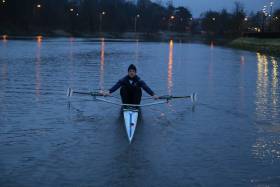Displaying items by tag: Lagan Scullers' Head of the River
Doyle is Afloat Rower of the Month for February
#Rower of the Month: Philip Doyle of Queen’s University is the Afloat Rower of the Month for February. The big medical student was the fastest single sculler at the Lagan Scullers’ Head of the River. He covered the course in under 12 minutes and had just over 17 seconds to spare over Portadown’s Sam McKeown.
Rower of the Month awards: The judging panel is made up of Liam Gorman, rowing correspondent of The Irish Times, and David O'Brien, editor of Afloat magazine. Monthly awards for achievements during the year will appear on afloat.ie and the overall national award will be presented to the person or crew who, in the judges' opinion, achieved the most notable results in, or made the most significant contribution to rowing during 2016. Keep a monthly eye on progress and watch our 2016 champions list grow.





























































